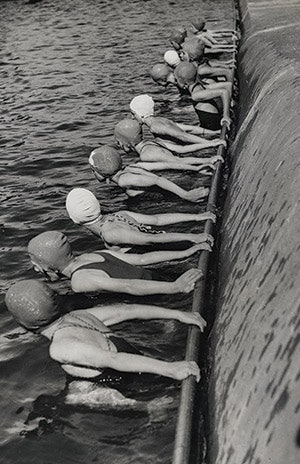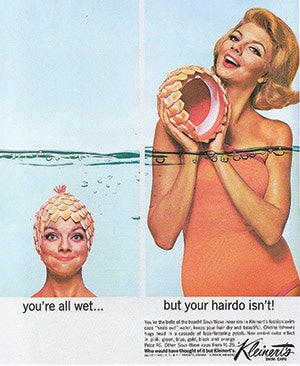


Swim caps have been in use since ancient times by both men and women to protect hair while bathing or swimming. Early caps were made of waxed taffeta or silk.
The era of the modern swim cap started in the industrial watershed year of 1883, when rubber manufacturing first came on the scene, opening the door to a spectrum of durable and affordable consumer products. As luck would have it, rubber swim caps became available at a time when public swimming pools were showing up in a majority of major cities in the U.S. and elsewhere.
At first, swim caps were all about utility. Early rubber caps strongly resembled aviator helmets with chinstraps to hold them in place. By the 1920s with the introduction of latex swim caps became more elastic and could be made to fit more tightly, an aquatic complement to the snug-fitting headwear that was popular during the Jazz age. During that time, swim caps were sold as part of entire swim wear outfits and were widely considered an essential fashion accessory.
The availability of swim caps and bathing suits in general took a major hit in World War II when rubber and its derivative materials were used in the war effort. (Interestingly, it was this same need to conserve material that lead to the development of the first two-piece swim suits for women, known as the legendary bikini.)
After the war, swim caps quickly regained popularity as vets moved into the suburbs giving rise to the middleclass backyard pool. That trend was stoked in part by the aquatic movie extravaganzas of the 40s and 50s starring movie and swimming icon Esther Williams. In the ultimate expressions of aquatic style and performing arts, Williams’ costumes and those of her co-performers almost always featured colorful swim caps that were stylishly decorated.
In 1972, swimming and the attendant use of swim caps received a boost popularity. That year, Mark Spitz thrilled the world by winning seven gold medals at the Munich Summer Olympic Games. Although he did not wear a cap himself, the popularity of swimming increased dramatically in the wake of Spitz’ heroics. In time, Olympic swimmers seeking a competitive edge turned to swim caps as a way to reduce drag in the water while protecting their heads from the elements, which boosted the swim cap’s appeal to the swimming masses.
Today’s caps are made from a variety of materials including silicone, latex, Lycra and Neoprene. Used primarily for competition these days, caps are designed for specific sports including swimming, diving, water polo, synchronized swimming and surfing.
The use of swim caps have also been recommended as a way to reduce the risk of hair entanglement accidents.
Although it’s unclear whether or not swim caps will ever again be regarded as a fashion necessity, the fundamental benefits of protecting bathers and increasing athletic performance ensures they will remain a familiar aquatic accessory.











































